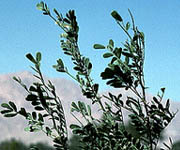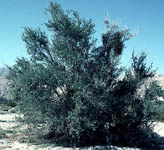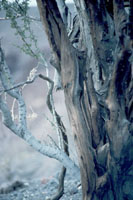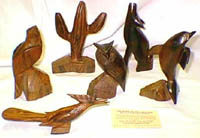

I have recently discovered Desert Ironwood, Olneya tesota, and want to use it in my intarsia, as well as try to carve it, or make jewelry and beads from the scraps. The lettering that you see on this page is electronically "carved" out of a scan of the actual wood, to give you an idea of its appeal.
I have heard that it is a very toxic wood, but can find no information supporting this claim. If you know something about the toxicity, and can document it with a written source, please email me!
I would also like to know what scrollsaw blade would be the best for cutting through this Ironwood. I plan on treating it like ebony or bois d'arc (osage orange), until otherwise guided by those who know better.
My email address is: [email protected]
Thanks!
Also known as Arizona ironwood, desert ironwood, palo-de-hierro, tesota, palo de fierro and palofierro (which literally translated means "iron rod").
The bluish gray-green leaves are pinnately compound to 2" long with leaflets to 0.75" long, and deciduous; the old leaves fall after bloom, but are quickly replaced with new leaves. Although classified as an evergreen, it is deciduous in hard frosts and cannot endure prolonged freezes. It can, however, tolerate any amount of summer heat.

The Ironwood's seeds are eaten by birds and animals and were eaten by the Native American People who once inhabited the foothills. Early settlers used it for firewood and it was used by Native Americans for tool handles and arrowheads.
Phainopeplas birds nest in the Ironwood trees and eat the juicy berries of the parasitic desert mistletoe, which grows on the tree's branches. When these birds fly between trees, they distribute the sticky mistletoe seeds in their droppings. In winter, mule deer also feed on the mistletoe.

The geographic distribution of the native Desert Ironwood is limited to the Sonoran Desert. The Sonora Desert is located in the northwestern part of Mexico and includes part of California and Arizona. The Ironwood grows as small, sparse trees in this area.

The wood is used for furniture and wood carvings, and as a result, in some areas of California and Mexico, mature trees have become rare. The living specimens are now protected, and the removal of the dead wood from the area is strictly regulated. No dead wood less than 100 years old may be taken from the area.
Commercial carving of Ironwood has come about during the past 25 years, mostly done by the Seri Indians of Mexico. Again, only dead trees are used in the carvings, most of which, after having grown for more than half a century, have laid in the desert sun with temperatures exceeding 140 degrees F. for over 100 years.
The dry and relatively ice-free climate in the Sonoran Desert makes decomposition a slow process. Generations of termites and desert millipedes will gnaw, sometimes for hundreds of years, at a majestic deadwood snag, making the nutrients of the dead tree available for the organisms in the ecosystem.

The wood is picked up or dug out by hand in the desert, in pieces of different shapes and sizes, mostly small and medium ones. A large carving made only from one piece of wood, with no assembled parts, is a rarity and very valuable( some in the thousands of dollars ).

These figures include porpoises, tortoises, sea turtles, whales, sailfish, roadrunners, deer, owls, cacti, ducks, eagles, buffalos and bears. According to tradition, these carvings made from the "sacred tree" bring good fortune and long life.
If you come across any others, please let me know!

You are visitor number:
Updated: November 10, 1998